| Author |
Message |
|
Justin H. Núñez
|
 Posted: Wed 02 Dec, 2009 9:15 am Post subject: Sword suspensions Posted: Wed 02 Dec, 2009 9:15 am Post subject: Sword suspensions |
 |
|
I was thinking that we need a thread on sword suspensions. I mean we have threads for practically everything else I have not seen one specifically on this.
I often find myself wondering at the suspensions and their related accouterments more than the actual weapons. So any care to post pics or your sword belts and suspensions. Any period, any place.
"Nothing in fencing is really difficult, it just takes work." - Aldo Nadi
|
|
  |
 |
Ville Vinje

|
 Posted: Wed 02 Dec, 2009 9:55 am Post subject: Posted: Wed 02 Dec, 2009 9:55 am Post subject: |
 |
|
Use the search funtion. There are several posts per week on the subject.
Regards,
/Ville
|
|
   |
 |
Michael Edelson

|
|
   |
 |
Sean Flynt

|
 Posted: Fri 04 Dec, 2009 11:20 am Post subject: Posted: Fri 04 Dec, 2009 11:20 am Post subject: |
 |
|
My first scabbard/supension (only a few months old as of this writing) is typically Austrian, ca. 1480-1525. I have a similar project underway now. It's worth noting that suspensions and scabbards were subject to regional tastes. You could pair an historical scabbard with an historical suspension and still come up with something a-historical if you're not careful. That's one of the many reasons I look at artwork of the period for ideas and justification.
With so many people making scabbards these days I'm surprised so few folks are also making chappes (a.k.a., "rain guards,") which art-historical evidence suggests were an integral part of the scabbard/suspension system of many or most late-medieval swords (in Northern Europe, at least). I've said elsewhere here that the properly-fit tubular chappe helps retain the sword in the scabbard, just as the construction of the scabbard itself and suspension do.
Even if these devices were primarily defensive, as some have argued, artwork and surviving examples reveal that the tubular style shown here was carefully fit to the scabbard mouth, which is tricky to manage, let me tell you.  For the chappe to fit properly, you have to make the scabbard first, complete with the horizontal riser where the chappe will end. That's more than an aesthetic decision, though, because that riser also serves to prevent the suspension knot from moving up when only a single knot is used. So, in theory, you need an assembled sword in the scabbard so you can fine-tune the balance by the placement of that riser. But you can't secure the hilt until you make the chappe, which in at least some cases sits under or around the base of the grip and is stitched in place. And you can't include a chappe in the rough assembly because until you have the sword in the scabbard you won't know exactly where the riser should be, and if you don't know where the riser should be you have no idea how long the chappe needs to be anyway! I haven't measured to see how much difference one half-inch might make in the placement of the riser (historic tubular chappe lengths appear to vary by approx. .75") , but it should have some effect on the angle of the sword when worn. For the chappe to fit properly, you have to make the scabbard first, complete with the horizontal riser where the chappe will end. That's more than an aesthetic decision, though, because that riser also serves to prevent the suspension knot from moving up when only a single knot is used. So, in theory, you need an assembled sword in the scabbard so you can fine-tune the balance by the placement of that riser. But you can't secure the hilt until you make the chappe, which in at least some cases sits under or around the base of the grip and is stitched in place. And you can't include a chappe in the rough assembly because until you have the sword in the scabbard you won't know exactly where the riser should be, and if you don't know where the riser should be you have no idea how long the chappe needs to be anyway! I haven't measured to see how much difference one half-inch might make in the placement of the riser (historic tubular chappe lengths appear to vary by approx. .75") , but it should have some effect on the angle of the sword when worn.
I'm making scabbards, but I don't consider myself a proper scabbard maker. I find the work to be much more challenging and exacting than the basic sword cutlery I'm doing. I think I had to take apart my current project three times to refine the fit. If you've ever wondered about the $1,000+ price of custom historical scabbards, all I can say is, "try it".

 Attachment: 129.92 KB Attachment: 129.92 KB
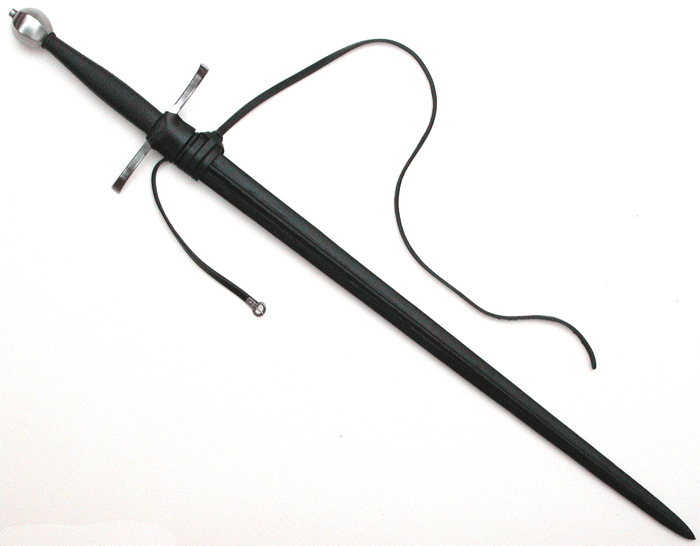
 Attachment: 214 KB Attachment: 214 KB
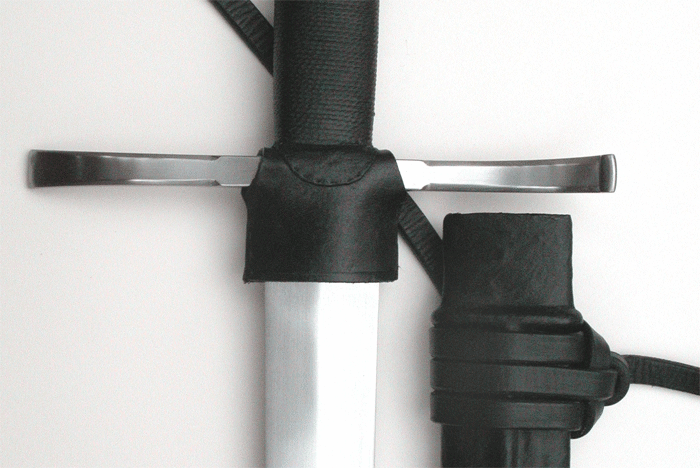
-Sean
Author of the Little Hammer novel
https://www.amazon.com/Little-Hammer-Sean-Flynt/dp/B08XN7HZ82/ref=sr_1_1?dchild=1&keywords=little+hammer+book&qid=1627482034&sr=8-1
|
|
   |
 |
Sean Flynt

|
|
   |
 |
Sean Flynt

|
 Posted: Fri 04 Dec, 2009 1:18 pm Post subject: Posted: Fri 04 Dec, 2009 1:18 pm Post subject: |
 |
|
Here a few more. Notice the trend here--narrow belts and single knots, no matter the size of the sword. In other words, the complete suspension is nothing more than a long, narrow belt and simple buckle. The last two images below makes the point especially well. The executioners are wearing messers and the suspensions of the sword scabbards are also clearly visible. Though of very different weight, size and balance, the messers and swords have identical suspensions.
 Attachment: 175.48 KB Attachment: 175.48 KB
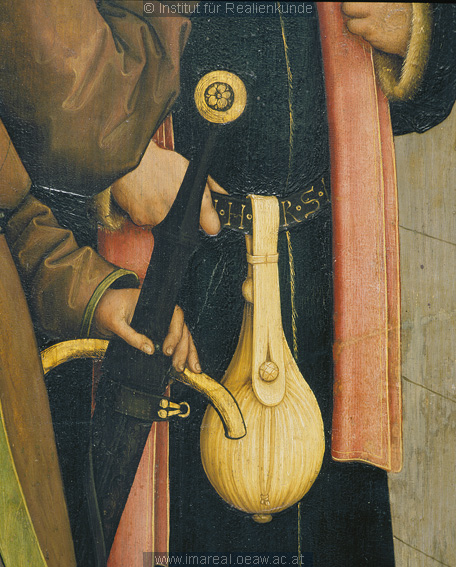
 Attachment: 170.01 KB Attachment: 170.01 KB
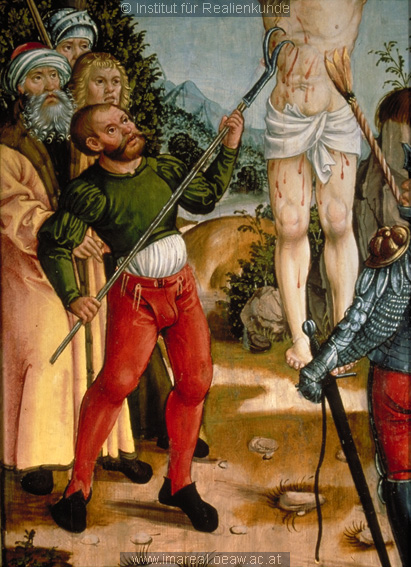
 Attachment: 154.49 KB Attachment: 154.49 KB
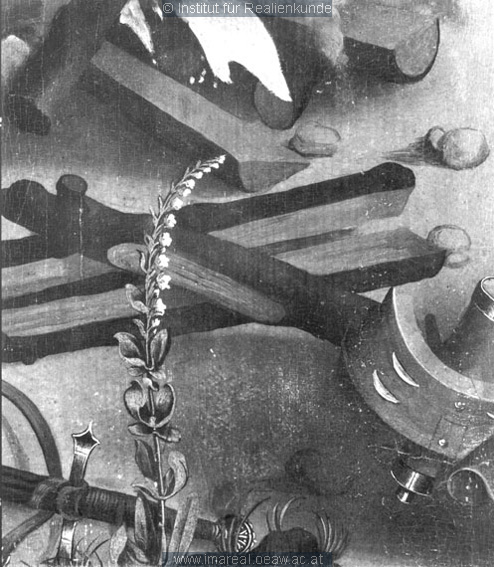
 Attachment: 179.18 KB Attachment: 179.18 KB
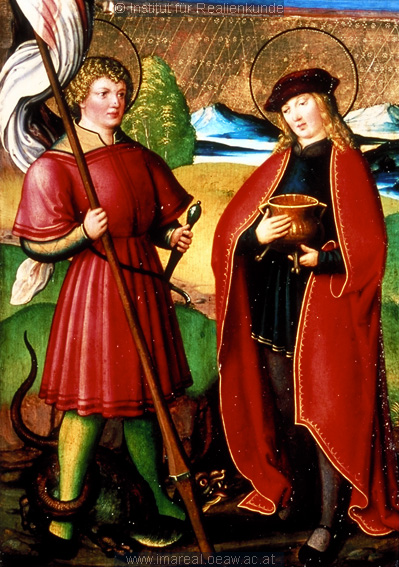
 Attachment: 213.33 KB Attachment: 213.33 KB
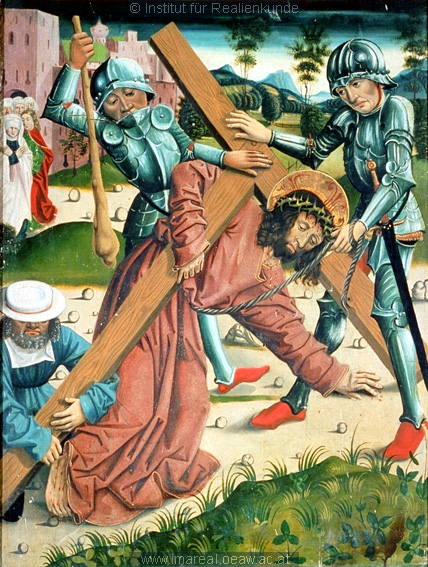
 Attachment: 171.87 KB Attachment: 171.87 KB
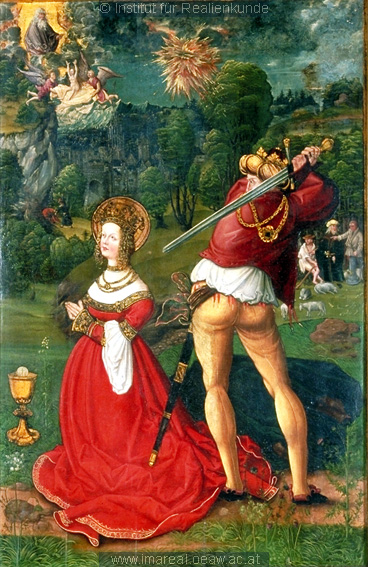
 Attachment: 191.42 KB Attachment: 191.42 KB
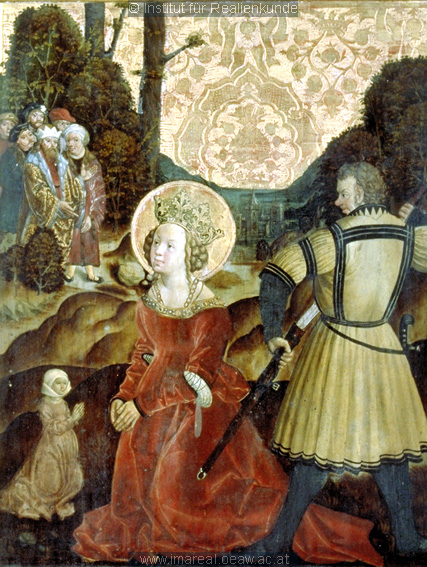
 Attachment: 168.47 KB Attachment: 168.47 KB
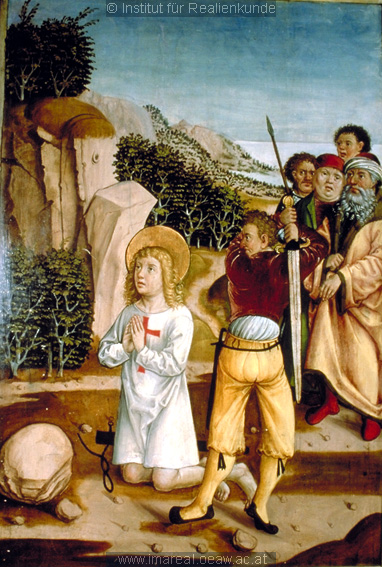
-Sean
Author of the Little Hammer novel
https://www.amazon.com/Little-Hammer-Sean-Flynt/dp/B08XN7HZ82/ref=sr_1_1?dchild=1&keywords=little+hammer+book&qid=1627482034&sr=8-1
Last edited by Sean Flynt on Fri 04 Dec, 2009 1:36 pm; edited 1 time in total
|
|
   |
 |
Sean Flynt

|
 Posted: Fri 04 Dec, 2009 1:25 pm Post subject: Posted: Fri 04 Dec, 2009 1:25 pm Post subject: |
 |
|
One last example, of a fabric type (silk?) seen post-1500 and sometimes seen in use with the Katzbalger (notice the Katzbalger hilt directly behind the victim). Of special note is the phallic shape and position of the "buckle" knot, as well as the size of the sword this suspension carries. Hmmm...maybe I should try this with my new scabbard project. It would be a perfect match, chronologically and culturally, and I'd definitely be the only person on my block to have one. Also, I wouldn't have to make another buckle! Maybe I can find a long yellow or red scarf....
 Attachment: 175.71 KB Attachment: 175.71 KB
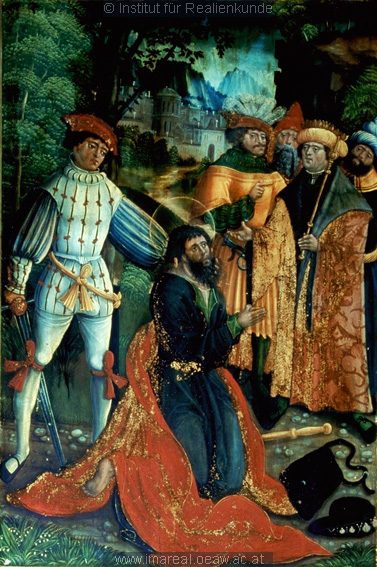
-Sean
Author of the Little Hammer novel
https://www.amazon.com/Little-Hammer-Sean-Flynt/dp/B08XN7HZ82/ref=sr_1_1?dchild=1&keywords=little+hammer+book&qid=1627482034&sr=8-1
|
|
   |
 |
|
Justin H. Núñez
|
 Posted: Sat 05 Dec, 2009 5:22 pm Post subject: Posted: Sat 05 Dec, 2009 5:22 pm Post subject: |
 |
|
Those are all great pics. I always find interesting how understated (and sublimly simple) many suspensions are in comparison with the average "complicated knight sword belt" ideas that many people have. Thanks for sharing those.
What I also find interesting is variety of ways that different cultures experimented with their own suspension ideas. I am thinking in particular the different variations of the celtic La Tene period, as well as a the various nordic ideas and the middle eastern ideas of how a sword should be carried, vertical as opposed to obliquely and how they accomplished the varying angles. There was an article I read (rather poorly, as it was in French and I am limited to Spanish and English for the moment) about the different phases of the celtic sword belt. Sorry if I am rather rambling. I will try to gather my thoughts and post somthing more coherent.
"Nothing in fencing is really difficult, it just takes work." - Aldo Nadi
|
|
  |
 |
|
Al Muckart
|
 Posted: Sun 06 Dec, 2009 10:32 am Post subject: Posted: Sun 06 Dec, 2009 10:32 am Post subject: |
 |
|
Sean, thank you for posting those pictures. Some of them are of immediate use to me 
Something that would make them (and pictures posted here in general) a lot more useful would be if they were labelled with some information as to the artist and the timeframe so people like me looking for something in a fairly specific time can follow them up. I don't know if you have that information in your library of pictures though.
I do note that most, if not all, of the swords pictured with a single knot suspension are relatively short. I wonder how well that'd work with longswords where the blade is longer than the wearer's hip-foot measurement?
--
Al.
http://wherearetheelves.net
|
|
   |
 |
|
Brogdon Combs
Location: Tallahassee, Florida, USA Joined: 22 Jan 2009
Posts: 52
|
 Posted: Sun 06 Dec, 2009 6:44 pm Post subject: Posted: Sun 06 Dec, 2009 6:44 pm Post subject: |
 |
|
Hello,
I don't mean to get off-topic, but would any of you mind explaining how this type of knot is tied, and how it works? Also, I'd greatly appreciate a slight bit of general historical background on it, as in, what types of swords typically utilized this type of suspension.
Thank you very much,
Brogdon
| Michael Edelson wrote: | Here is a 15th century scabbard/suspension I made recently:

 |
"Here's to you, mister pirate-ship-captain! With your endless booty calls and a violent streak that makes Grand Theft Auto look like Super Mario Kart, only you could bring the wooden leg back into fashion, and only you could fight three men at a time with a patch over one eye and a hook for a hand."
-Strongblade.com
|
|
  |
 |
JE Sarge
Industry Professional

|
 Posted: Sun 06 Dec, 2009 7:01 pm Post subject: Posted: Sun 06 Dec, 2009 7:01 pm Post subject: |
 |
|
Brogdon,
You'll find more information on the knot, including how to tie it here:
http://www.myArmoury.com/talk/viewtopic.php?t=6361

J.E. Sarge
Crusader Monk Sword Scabbards and Customizations
www.crusadermonk.com
"But lack of documentation, especially for such early times, is not to be considered as evidence of non-existance." - Ewart Oakeshott
|
|
  |
 |
|
Brogdon Combs
Location: Tallahassee, Florida, USA Joined: 22 Jan 2009
Posts: 52
|
 Posted: Sun 06 Dec, 2009 8:32 pm Post subject: Posted: Sun 06 Dec, 2009 8:32 pm Post subject: |
 |
|
Thanks, man. Much appreciated! 
-Brogdon
"Here's to you, mister pirate-ship-captain! With your endless booty calls and a violent streak that makes Grand Theft Auto look like Super Mario Kart, only you could bring the wooden leg back into fashion, and only you could fight three men at a time with a patch over one eye and a hook for a hand."
-Strongblade.com
|
|
  |
 |
Sean Flynt

|
 Posted: Mon 07 Dec, 2009 7:37 am Post subject: Posted: Mon 07 Dec, 2009 7:37 am Post subject: |
 |
|
| Al Muckart wrote: | Sean, thank you for posting those pictures. Some of them are of immediate use to me 
Something that would make them (and pictures posted here in general) a lot more useful would be if they were labelled with some information as to the artist and the timeframe so people like me looking for something in a fairly specific time can follow them up. I don't know if you have that information in your library of pictures though.
I do note that most, if not all, of the swords pictured with a single knot suspension are relatively short. I wonder how well that'd work with longswords where the blade is longer than the wearer's hip-foot measurement? |
It's true that the Austrians appear to have been very fond of blades of single-hand length, but with hand-and-a-half or two-hand grips, especially after ~1500 .Still, there are a number of true longswords shown above. A few of them are very helpfully held vertically so we can use biometrics to gauge length. Those come up to, or past, the figure's true waist, which is where a typical longsword hits most of us today (around 48",) with blades exceeding the foot-hip length you mention. When worn, these swords don't hang straight down, even when used with the single knot suspension. The position of the knot and the weight of the pommel keep the weapon at an appropriate angle. Also, if you look closely at the knot on my scabbard, you can see that this particular knot encourages a slight angle--the buckle end emerges from the top of the knot while the tongue end heads out from the knot at a right angle to the scabbard. All of this allows the weapon just enough of an angle to clear the ground. Of course, tightening the belt also raises the overall level of the sword--you have at least five inches to work with there, from hip to true waist.
As for details--all of these are Austrian, 1480-1525. There's too much data at IMAREAL to get it all for each image (I've collected hundreds!) but I tend save the file by the date listed in the database unless I think the period is self-evident or I don't need an exact date. If there are some in particular above that intrigue you, let me know which ones and I'll see if I have dates for them.
As far as I can tell, the IMAREAL dates are approximate in most cases (I think they refer to the first appearance of the image in historical records). The clothing, armour and arms suggest a date about as well as the actual dates do. In any case, all of the data is at IMAREAL. If you want to see swords or sword scabbards or armour or clothing or ANYTHING of, say, 1507, 1422, 1480-1490, etc., you just enter your dates, choose "material object" from the menu and proceed from there (in German). "Schwert" is a good search term to begin with. Be sure to let all of the images load before you look at any of them or you'll have to reload the huge page every time you back up.
http://www.imareal.oeaw.ac.at/realonline/
-Sean
Author of the Little Hammer novel
https://www.amazon.com/Little-Hammer-Sean-Flynt/dp/B08XN7HZ82/ref=sr_1_1?dchild=1&keywords=little+hammer+book&qid=1627482034&sr=8-1
|
|
   |
 |
Sean Flynt

|
|
   |
 |
Sean Flynt

|
|
   |
 |
|
Al Muckart
|
 Posted: Thu 10 Dec, 2009 7:01 pm Post subject: Posted: Thu 10 Dec, 2009 7:01 pm Post subject: |
 |
|
Thanks Sean, and thanks for the explanation of IMAREAL. I'll have more of a play with it soon.
With some luck in the next 6 months I'll be taking delivery of a longsword that I'll be building a grip covering, chappe, scabbard and suspension for. I'm planning on doing a two-point suspension after the Trinity Altarpiece and and one of the Portinari paintings by Hugo van der Goes.
The clearest place to see these is on Albion's regent and viceroy scabbards. I like them for the ability to just unhook the sword from the belt, but I can't for the life of me find anyone who manufactures the buckles and fittings to do this and having done ones for my knight scabbard I'm not real keen on doing more. That sort of metalwork isn't really my thing.
 Attachment: 170 KB Attachment: 170 KB
Detail from Sts Margaret and Mary Magdalene with Maria Portinari
1476-79, Hugo van der Goes [ Download ]
--
Al.
http://wherearetheelves.net
|
|
   |
 |
Sean Flynt

|
|
   |
 |
Sean Flynt

|
|
   |
 |
Sean Flynt

|
|
   |
 |
Sean Flynt

|
|
   |
 |
|
|
You cannot post new topics in this forum
You cannot reply to topics in this forum
You cannot edit your posts in this forum
You cannot delete your posts in this forum
You cannot vote in polls in this forum
You cannot attach files in this forum
You can download files in this forum
|
All contents © Copyright 2003-2024 myArmoury.com — All rights reserved
Discussion forums powered by phpBB © The phpBB Group
Switch to the Basic Low-bandwidth Version of the forum
|

